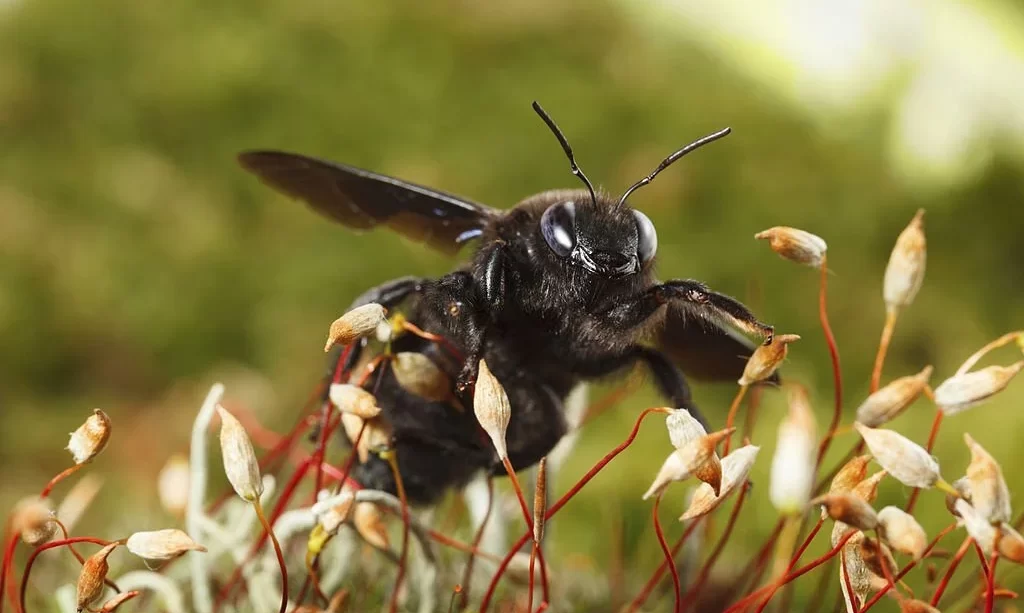In the world of insects, one group stands out for its intriguing behavior and distinctive appearance—the carpenter bees. These remarkable insects have earned their name for their unique habit of boring into wood, creating intricate tunnels and galleries that serve as their homes. As we delve into the world of carpenter bees, a question often arises: do these industrious creatures have a queen within their colonies, similar to honeybees or bumblebees? To uncover the truth behind this query, we must first explore the fundamentals of carpenter bees and their solitary lifestyle.
Carpenter Bee Basics
Carpenter bees, scientifically known as Xylocopa, are sizable bees that belong to the Apidae family. They are known for their robust and often imposing appearance, with some species showcasing a striking black coloration while others exhibit a metallic, iridescent sheen. Carpenter bees can be easily identified by their large, robust bodies and distinctive habit of hovering near wooden structures, such as decks, fences, or eaves.
One of the most notable aspects of carpenter bees is their preference for wood as both shelter and nesting sites. Unlike honeybees, which construct intricate hives with thousands of individuals, carpenter bees are solitary creatures. They create tunnels and burrows within wood, where they fashion small chambers as nesting sites. Each tunnel is typically inhabited by a single carpenter bee, and they are known for their impressive woodworking skills, excavating perfectly round entry holes with remarkable precision.
In contrast to social bees like honeybees and bumblebees, carpenter bees do not have elaborate colonies with queens, workers, and drones. Instead, they lead solitary lives, with each female carpenter bee responsible for provisioning her own nest and laying eggs. To understand the role of carpenter bees and whether a queen exists within their ranks, we must delve further into their unique lifestyle and reproductive habits.
Bee Hives
Before we can fully grasp the nature of carpenter bees and whether they have queens, it’s essential to have a broader understanding of bee colonies and hive structures.
Complex Bee Colonies: In the realm of bees, there are two primary categories: social and solitary bees. Social bees, such as honeybees and bumblebees, form complex colonies with intricate hierarchies. These colonies consist of thousands of individual bees, each with a specific role. At the heart of these social colonies is the queen bee, the sole fertile female responsible for laying eggs and perpetuating the colony.
Highly Organized Societies: Social bee colonies are marvels of organization and cooperation. They consist of the queen, whose primary task is reproduction, worker bees responsible for foraging and maintaining the hive, and drones, whose sole purpose is to mate with the queen. This division of labor ensures the survival and growth of the colony.
The Solitary Nature of Carpenter Bees
Carpenter bees, on the other hand, follow a different path in the world of bees—one of solitude.
Solitary Nesters: Carpenter bees are solitary by nature, meaning that each female bee lives and reproduces independently. Unlike social bees that build communal hives, carpenter bees construct individual tunnels or burrows within wood to serve as their nests. These tunnels are meticulously crafted, with each female responsible for excavating and provisioning her own nesting site.
No Queen in Sight: In the world of carpenter bees, there is no queen bee as we typically think of in social bee colonies. Instead, each female carpenter bee is a self-sufficient entity, capable of reproducing on her own. She lays eggs within her chosen nesting chamber, provides food for her offspring, and guards her tunnel, ensuring the survival of her brood.
This solitary lifestyle sets carpenter bees apart from their social bee counterparts and, in turn, dispels the notion of a queen reigning over their colonies. Understanding the unique solitary nature of carpenter bees sheds light on their fascinating behavior and lifestyle, which we will further explore as we uncover the details of their reproduction and nesting habits.
Reproduction Among Carpenter Bees
Reproduction among carpenter bees is a remarkable process that underscores their solitary nature and dispels any notion of a queen governing their colonies.
Mating and Nesting: Carpenter bees engage in a distinctive mating ritual. Male carpenter bees, known as drones, seek out females and court them with elaborate flight displays. Once a female accepts a suitor, they mate, and she stores the collected sperm for future use. The female then selects a suitable wooden site for her nest and begins the intricate process of excavating a tunnel within the wood.
Egg-Laying and Nesting: Within the carefully crafted tunnel, the female carpenter bee lays a series of eggs, typically separated by partitions of chewed wood pulp. She meticulously provisions each chamber with a mixture of nectar and pollen, which will serve as sustenance for her developing offspring. After the eggs are laid and the chambers provisioned, the female seals off the tunnel, ensuring the safety and privacy of her brood.
The Role of Female Carpenter Bees
The life of a female carpenter bee is one of industrious self-sufficiency, where she plays multiple roles to ensure the survival of her offspring.
Excavation and Nest Building: Female carpenter bees exhibit remarkable woodworking skills. They use their mandibles to chew through wood, creating tunnels that can extend several inches deep. The precision of their entry holes and the construction of nesting chambers demonstrate their craftsmanship.
Egg-Laying and Provisioning: As mentioned earlier, female carpenter bees are responsible for both laying eggs and providing nourishment for their developing larvae. This dual role showcases their dedication to ensuring the survival of their progeny.
Guardians of the Nest: Female carpenter bees diligently guard their nests, protecting them from potential threats. They are known to be territorial and will defend their nesting sites if they sense any intrusion.
Conclusion
In the world of carpenter bees, the absence of a queen is a defining characteristic. These industrious insects live solitary lives, with each female carpenter bee functioning as both architect and provider for her offspring. Their remarkable nesting and reproductive behaviors reflect the unique nature of these solitary bees, setting them apart from their social bee counterparts.
Understanding the role of female carpenter bees and the intricacies of their solitary lifestyle offers a deeper appreciation for these fascinating insects. While they may not have queens in their colonies, carpenter bees are a testament to the diversity of nature’s creations and the remarkable ways in which different species adapt to thrive in their respective habitats.



